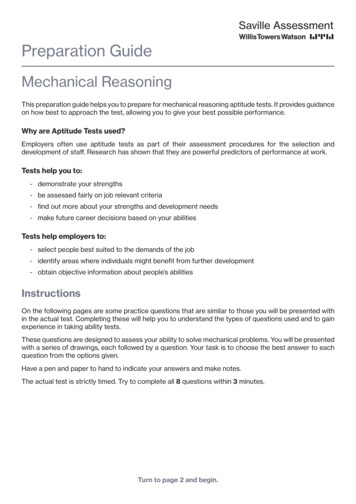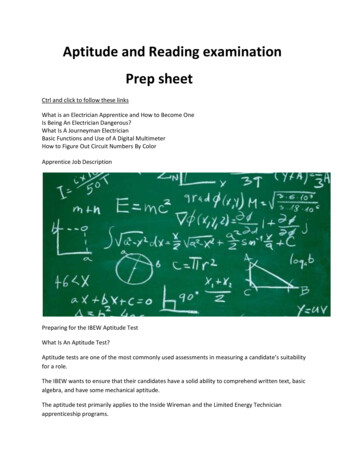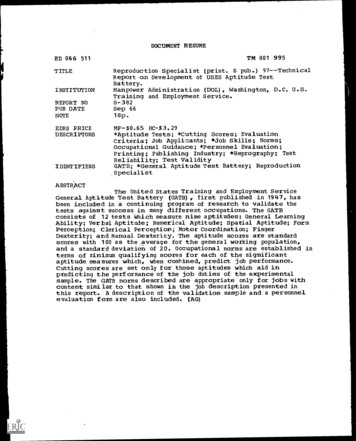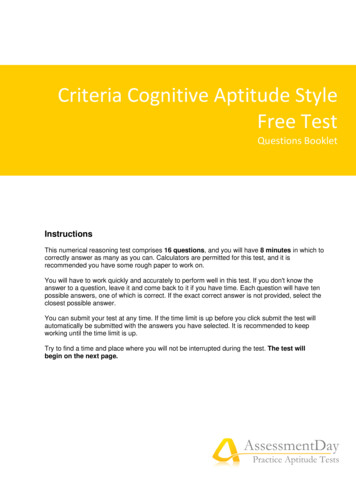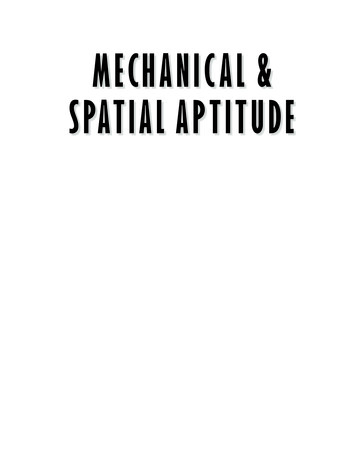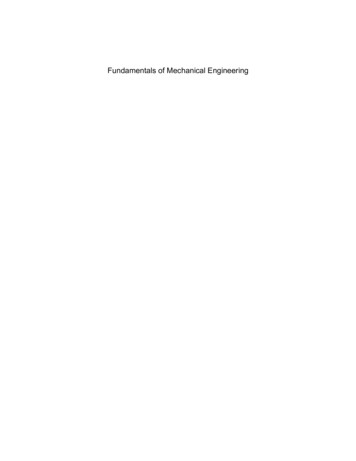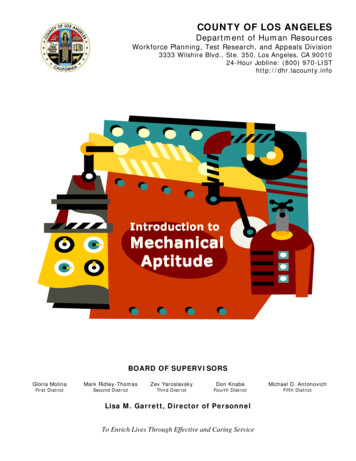
Transcription
COUNTY OF LOS ANGELESDepartment of Human ResourcesWorkforce Planning, Test Research, and Appeals Division3333 Wilshire Blvd., Ste. 350, Los Angeles, CA 9001024-Hour Jobline: (800) 970-LISThttp://dhr.lacounty.infoIntroduction toMechanicalAptitudeBOARD OF SUPERVISORSGloria MolinaFirst DistrictMark Ridley-ThomasSecond DistrictZev YaroslavskyThird DistrictDon KnabeFourth DistrictLisa M. Garrett, Director of PersonnelTo Enrich Lives Through Effective and Caring ServiceMichael D. AntonovichFifth District
Table of ContentsForeword.2Purpose .2Objectives .2Who should use this guide? .2Disclaimer .2Introduction.3What is mechanical aptitude?.3How is mechanical aptitude assessed?.4Gravity .5Mechanical Reasoning .7Wheels and Axles (pulleys and gears) .7Levers . 10Inclined Plane . 13Wedge . 15Screws (Threaded Hardware) . 16Visual/Spatial Relations . 18Hidden Figure . 18Spatial Views . 19Block Counting. 20Paper Folding. 21Tool Knowledge. 23Tool Identification . 23Tool Usage . 24Conclusion . 25Bibliography. 26About the Authors . 271
ForewordWelcome! The County of Los Angeles Department of Human Resources is pleased to offerIntroduction to Mechanical Aptitude as the latest in a series of information guides* developedby the Test Research Unit. We hope that you find it useful in enhancing your learning andcareer endeavors.PurposeThis guide has been developed to introduce you to the basic concepts of mechanical aptitude.ObjectivesThis guide has been designed to convey to you an understanding of the definition of mechanical aptitude.the types of test questions that are typically included in mechanical aptitude tests.recommended strategies for analyzing and solving different question types.Who should use this guide?The guide could be helpful to anyone interested in learning about the basic concepts ofmechanical aptitude; however, it is written specifically within the framework of helping thereader answer various types of mechanical aptitude test questions.DisclaimerThis guide provides an introduction to this subject matter only; further study of the subjectand related concepts may be necessary to gain the knowledge, skills, and abilities needed toachieve your learning and/or career goals. Although this guide presents useful and practicalinformation from this subject area, there is no guarantee that someone who reads it will beable to perform better on the job or on a County examination. By merely using this guide,you consent to understanding and agreeing with this disclaimer.* To obtain other resources, please visit the Department of Human Resources website(http://hr.lacounty.info) and click on “Job Information” and “Employment Test Preparation.”2
IntroductionWhat is mechanical aptitude?Mechanical aptitude describes the capacity to apply simple mechanical and physicalprinciples. In other words, it describes a person’s ability to figure out how objects work andmove, alone and in relation to other objects.People often use mechanical aptitude to conquer routine problems. For example, mechanicalaptitude is an underlying capacity that helps a person understand how to use a jack to fix aflat tire, assemble a cardboard storage box, install a new ink cartridge into a printer, andmaneuver furniture through doorways and around corners to place it in a new location. Ofcourse, the extent to which a person uses mechanical aptitude depends on the activities heor she must accomplish. Successful performance of tasks in many occupations – such as thetrades – relies upon workers having strong mechanical aptitude.The concept of mechanical aptitude can include several components: general mechanicalreasoning, visual/spatial relations abilities, and specific tool knowledge. Mechanical reasoning has to do with your understanding of how simple machines work.Simple machines are defined as those requiring the application of a single force towork. Basic simple machines are the wheel and axle, lever, and inclined plane.Example:Wheel and Axle LeverInclined PlaneVisual/spatial relations has to do with your understanding of how objects can be movedor oriented in different directions (i.e., at different angles) and still maintain theiroriginal characteristics and identity (i.e., they are still the same thing).Example:This cube is presented in two spatial orientations. Even though it has beenmoved in different directions, it still has the same characteristics (i.e., sixsides of the same size) and identity (i.e., a cube). Tool knowledge has to do with your familiarity with tools and how they are used. It issometimes thought to be separate from mechanical aptitude because it is built uponfundamental mechanical reasoning and visual/spatial relations abilities.Note: Though included in some definitions of mechanical aptitude, basic mathematics skillwill not be addressed in this guide. You may reference the Basic Mathematics Study Guideand Sample Test Questions if you feel that you need assistance in this area.3
How is mechanical aptitude assessed?While there are several ways to assess mechanical aptitude, the multiple-choice written testis often used because it is cost-effective, efficient, and useful. Written mechanical aptitudequestions typically present a picture or diagram of an object or situation that you mustanalyze in order to find an answer to a question posed about it. You must then choose fromamong several possible responses, only one of which is correct.Mechanical aptitude tests present questions representing mechanical reasoning,visual/spatial relations, and/or tool knowledge. Also, because an understanding of gravityinfluences a person’s mechanical reasoning and visual/spatial relations abilities, manymechanical aptitude tests include questions that cover this concept.The next sections will illustrate examples of questions in each of these categories and offersuggestions for determining the correct response.Mechanical Aptitude ComponentSample Question Types1. Gravity Motionless Object Object in Motion2. Mechanical Reasoning Wheels and Axles (pulleys and gears)LeversInclined PlaneWedgeScrews (Threaded Hardware)3. Visual/Spatial Relations Hidden FigureSpatial ViewsBlock CountingPaper Folding4. Tool Knowledge Tool Types Tool Use4
GravityGravity is one of the fundamental laws of the physical universe. It is an important conceptthat must be understood in order to respond to many mechanical aptitude questions. Whilea full discussion of gravity is beyond the scope of this guide, for the purpose of answeringmechanical aptitude questions, you only need to know a few key facts.Key Facts Essentially, gravity is the constant downward force that keeps people and objects on theEarth. The force of gravity is such that it will create resistance for any other force or effort thattries to elevate an object above a resting point. In general, the force of gravity exerted upon every object is the same, regardless of theobject’s weight, size, shape, etc. Thus, objects moving only by the force of gravity (i.e.,in free fall) will move at the same rate toward a resting point.Mechanical aptitude questions related to gravity often involve falling objects, swingingpendulums, structural support components, etc. In this section, we will present examplequestions involving objects in motion and objects not in motion.Example:Situation ASituation BIf the objects presented above are not in motion, which represents an unlikelysituation?A.B.C.D.Situation ASituation BBoth are equally likelyBoth are equally unlikelyThe answer is B. Because gravity always pulls objects downward, the ball at the end of therope would be drawn straight down toward the ground. Hence, in the absence of some otherforce, such as a magnetic force, it is unlikely the ball would be suspended as presented inSituation B.5
Example:ABAssuming both balls are free-falling from the same height, which ball will reach theground first?A.B.C.D.Ball ABall BBoth will reach the ground at the same timeIt is impossible to tellThe answer is C. As stated in the key facts on page 5, regardless of their size, all free-fallingobjects on Earth accelerate downwards at the same rate.Gravity SummaryTypical mechanical aptitude tests do not ask questions about gravity in textbook form (e.g.,“What is an object’s rate of descent?”). Instead, they ask you to apply your understandingof how gravity operates in given situations (e.g., “Which of these two objects will hit theground first?”). The information presented in this section – together with what you probablyalready know from simply observing your environment – provides a foundation for answeringmechanical aptitude questions involving the force of gravity.6
Mechanical ReasoningQuestions related to mechanical reasoning test your understanding of the fundamentalprinciples of simple machines. As mentioned in the introduction, the wheel and axle, lever,and inclined plane are examples of simple machines. Other simple machines that aremodifications of these three include pulleys and gears, the wedge, and the screw. In thissection, we will present typical types of mechanical reasoning questions involving wheels andaxles, levers, inclined planes, wedges, and screws (threaded hardware).Wheels and Axles (pulleys and gears)Both pulleys and gears are variations of a wheel and axle. The following basic informationabout these simple machines can help you answer questions about how they work.A wheel and axle is a large wheel attached to a smaller shaft (axle) whichallows the wheel to rotate. The wheel and axle is the mechanism that makesa doorknob turn.Key Facts A wheel can be firmly affixed to the axle (i.e., a drive axle) or it canrotate freely on the axle. When the drive axle is turned, the wheel moves a greater distance thanthe axle.A pulley is a wheel that has a rope or belt wrapped around it. With a singlepulley, pulling down on the rope can lift an object attached to the other end.The single pulley is used in flagpoles, cranes, and water wells. Multiplepulleys can work together to move objects horizontally (such as on theconveyor belt at a grocery store) or distribute loads to allow the sameamount of force (input) to do more work, among other uses.Key Facts Two pulleys of the same size that are connected by a moving belt turn atthe same speed and in the same direction. If there is a twist in the belt,the pulleys will move in opposite directions. When moving at the same speed, smaller pulleys make more revolutionsin the same amount of time as larger pulleys.A gear is a wheel that has teeth around the outer edge. The gear is themechanism that makes clocks tick.Key Facts When the teeth of two gears fit together and one gear turns, it will causethe other gear to turn, but in the opposite direction. When the gears are the same size and they have the same number ofteeth, they both turn at the same speed. When moving at the same speed, smaller gears make more revolutions inthe same amount of time as larger gears.Questions about pulleys and gears test your knowledge of how force influences the directionof movement, and the relationship between pulley or gear size and the speed of rotation. Ina typical question, a set of pulleys or gears is presented and the direction in which force isapplied to one of the pulleys or gears is provided.7
Note: The terms clockwise and counterclockwise are often used to indicate the direction of rotation.Clockwise means rotation in the same direction as the hands on a clock (toward the right), andcounterclockwise indicates rotation in the opposite direction as the hands on a clock (toward the left).Example:Which of the pulleys will complete themost revolutions per minute?BA.B.C.D.ACPulley APulley BPulley CThe pulleys will make an equalnumber of revolutions perminute.The answer is A. Notice that pulley A is the smallest of the three pulleys in the series.Because of its relative size, it has a shorter distance to travel to complete one revolutionthan do the larger pulleys. Thus, it can make more revolutions in the same amount of time.Another way to phrase this question would be to ask which pulley is moving fastest, in whichcase the same answer and supporting thought process is used.AExample:If Pulley A is turning clockwise, Pulley B isturningA. clockwise.B. counterclockwise.BThe answer is B. As stated in the key facts on page 7, whenever there is a twist in the beltbetween two pulleys, the pulleys rotate in opposite directions.Solution Pointers for Pulleys questions: Rank the relative size of each pulley in the series. Convert size rank to speed rank. For example, if there are three pulleys, the largest oneis moving slowest and the smallest one is moving fastest, with the middle one in-betweenthe two.8
CExample:If gear A turns in the direction indicated by thearrow, which way will gear C turn?BAA.B.C.D.ClockwiseCounterclockwiseSame direction as gear AOpposite direction as gear BThe answer is B. Notice that gear A is moving in a clockwise direction. Given the direction ofrotation for gear A, we can see that the right side of the gear “tooth” on gear A is applyingforce to left side of the tooth on gear C. This force pushes gear C to the right, resulting in acounterclockwise rotation.Solution Pointers for Gears questions: Choose a gear with a known direction of movement as your starting point (also called thedriving gear because it dictates the direction the other gears will move). Follow themovement of this gear to where it makes contact with the next gear in the series. Focusing on this contact point (i.e., where force is applied), determine the direction thenext gear in the series will rotate. To do this, ask yourself which direction the teeth ofthe driving gear will move the teeth of the other gear. If the gear you are being asked about in the question is not in direct contact with thedriving gear, repeat the steps above to determine the direction that each gear will moveuntil you reach the gear identified in the question. When there are several gears in a series, one helpful technique is to draw arrows on eachgear to keep track of each rotation in the series.Other important considerations for pulleys and gears questions1. Not all questions about pulleys and gears will ask you to identify the pulley or gear thatmakes the most or fewest rotations within a given timeframe. Some questions will askfor the ratio of turns of one pulley or gear to turns of another pulley or gear. Thefollowing guideline can help you answer these types of questions:9 The ratio of size or number of teeth is identical to the ratio of rotations for gears andpulleys, respectively. For example, if the larger pulley is 20 inches around (or forgears, the larger has 20 teeth) and the smaller pulley is 10 inches around (or forgears, the smaller has 10 teeth), the smaller one will make twice as many rotations asthe larger one in the same amount of time.2. The main distinction between pulleys and gears is that, with pulleys, moving belts applythe force to the outside surfaces of other pulleys. With gears, the teeth apply force tocontact surfaces (i.e., the sides of other gear’s teeth). Hence, the force applied to pulleysis by pulling, whereas force applied to gears is by pushing.9
LeversA lever is a simple machine made with a bar that moves on a surface point called a fulcrum.Force (input) is exerted upon the bar to move (output) an object or load. The followinginformation about these simple machines will help you answer questions about how theywork.3rd Class Lever2nd Class Lever1st Class LeverAs depicted below, there are several types of levers which vary according to the location ofthe fulcrum:With this type of lever, the fulcrum is in between theload on one end and the force on the other.Example: CrowbarWhen you apply downward force (input)to one end of the crowbar, the oppositeend lifts upward at the point where thecrowbar meets the surface of a board soas to pry up a nail (output/load).FULCRUMWith this type of lever, the fulcrum is on the end, theload is in between, and the force is at the other end.Example: WheelbarrowFULCRUMWhen you lift up (input/force) on one endof the wheelbarrow it is raised at the pointwhere it meets a wheel (fulcrum) and thebarrow (output/load) is also lifted.With this type of lever, the fulcrum is on one end, theforce is in between, and the load is at the other end.FULCRUMExample: Baseball BatWhen you apply swinging force with yourhands (fulcrum), the bat moves to hit a ball(output/load).Most questions about levers focus on the 1st class of lever and are generally designed to testyour understanding of the concepts of leverage and weight distribution. Considering this, thefollowing key facts can be useful for answering the example questions on the next pages.Key Facts The fulcrum can be moved depending on the weight of the load to be lifted or the forceyou wish to exert. The closer the load is to the fulcrum, the easier it is to move. The shorter side of a lever has more work to do to counter the effect of a longer side. Generally, whenever force is applied to a point more distant from the fulcrum, less forceis needed to accomplish the same amount of work (i.e., more leverage is given). Hence,an equal amount of force will do more work as it moves away from the fulcrum.10
Example:The person on the left is lower than the person on the right. What can the person onthe right do in order to make the seesaw more level?A.B.C.D.Slide forwardSit up straightSlide backwardLean forwardThe answer is C. Because the load is nearly balanced, shifting the weight of the person onthe right further away from the fulcrum will accomplish the additional work needed tobalance the beam.Example:50 lbs.50 lbs.Lever ALever BWhich of the two levers require less force (in the direction indicated by the arrow) tolift the box?A.B.C.D.Lever ALever BBoth require an equal amount of force.Cannot be determined.The answer is A. This example is similar to the previous example with one exception: thelever is not the same length on both sides of the fulcrum. As stated in the key facts on page10, whenever force is applied to a point more distant from the fulcrum, less force is neededto accomplish the same amount of work. Both levers must accomplish the same amount ofwork (i.e., move a 50 pound load); however, Lever A will do so more easily because there ismore distance from the point of force to the fulcrum on Lever A than on Lever B.11
Example:40 lbs.60 lbs.50 lbs.Situation A50 lbs.Situation BOf the two situations depicted above,A.B.C.D.only A is physically possible.only B is physically possible.both A and B are physically possible.it is impossible to tell which of the two is possible.The answer is B. In Situation B, the length of the lever on both sides of the fulcrum is equal,as is the weight supported on each side. This represents a “balanced” situation. It isphysically impossible for the lever to remain balanced in Situation A because there is moreweight on the right side. Even if the weights of the load were equal, the lever would still notbalance because the right side of the lever is longer than the left side. As stated in the keyfacts on page 10, the shorter the side of the lever, the less work it can do to balance theeffect of a longer opposite side. Thus, it would be unable to counter the force of gravitypulling the weight of the load on the longer side downward.Solution Pointers for Levers questions: Evaluate the relative weights of the load(s) on the lever. Assess the distance between the load from the fulcrum and the force from the fulcrum.12
Inclined PlaneAn inclined plane is a flat, slanted surface (i.e., higher on one end) that is useful for movingobjects to another height. Examples include ramps, hillsides, and slides. Inclined planequestions assess your knowledge of how the degree of the incline (i.e., the steepness of theangle), the size and weight of the object, and gravity effect the movement of objects. Beloware some key facts that may be useful for answering questions about inclined planes.Key Facts The load and force move in the same direction along the plane. In other words, whenyou apply upward force to push a load up a plane, the load also moves upward. Whenyou apply downward force to push a load down a plane, the load also moves downward. Objects moved along an inclined plane will travel across a longer distance, and over alonger period of time, than if lifted straight up or dropped straight down. When moving an object up an incline, gravity is pulling the object down. Thus, the effortor force that you must exert to move the object up the incline is greater than the effortneeded to move an object down an incline. Resistance or friction is created where the surface of an object meets the surface of aninclined plane. This resistance makes the work of moving the object more difficult and/orslower, whether moving the object up or down the plane. The steeper the inclined plane (i.e., the more it approaches 90 degrees), the more easilyan object moves down it. The opposite is also true: the steeper the plane, the moredifficult it is to move an object up it.Example:GRAVITYBall ABall BGRAVITYIf Balls A and B above are the same size and weight, which will roll faster?A.B.C.D.Ball ABall BNeither will roll.They will roll at the same speed.The answer is A. Because the balls are the same size, only the steepness of the inclineinfluences how fast they will roll. As stated in the key facts above, the steeper the incline,the more easily an object will move downward. Hence, Ball A is able to roll faster thanBall B.13
Example:Box BBox A45o45oAssuming the boxes are of equal weight and made of the same material, which boxwill more easily slide down its ramp?A.B.C.D.Box ABox BThey will slide down with equal ease.Cannot be determined.The answer is B. Because the boxes weigh the same and are on the same degree of incline,the only factor to consider is the surface-to-surface contact area (friction), as indicated bythe dotted lines. As stated in the key facts on page 13, friction hinders the movement of anobject. Thus, the box with less friction will slide down the ramp more easily. Consideringonly the amount of contact (since the boxes are made of the same material), Box B has lesssurface-to-surface contact with the ramp when compared to Box A and the ramp. Thus, itwill move down the ramp more easily. If the boxes were the same size and weight, and were made of the same material, gravitywould be the only factor affecting movement down the plane and they would move withequal ease. If the boxes had the same weight and size, but were made of different materials, it wouldbe impossible to determine which one moves more easily without information about thematerials. This is because the smoothness or coarseness of the material on the surfaceof an object affects the amount or degree of friction that is created when it is moved orslid across another surface.Solution Pointers for Inclined Planes questions: Evaluate the components (e.g., weight, size, and material) of the load(s) on the plane. Assess the angle of the incline in relation to gravity and/or other inclines presented in thequestion. Remember to consider the effect of gravity.14
WedgeA wedge is formed by two inclined planes that are placed back to back. This forms a Vshaped object - typically a piece of wood or metal - that is thick at one end and slopes to athin edge at the other. Wedges are used for purposes such as holding things together,cutting or prying things apart, or stopping an object from moving. Examples of wedgesinclude: the blade of a knifeeach blade on a pair of scissorsthe sharp edge of an ax the edge of the shovelthe edge of a door stopthe end of a nailQuestions about wedges assess your knowledge of how the direction and angle of force isused to perform work on other objects, such as splitting wood or opening a jammed door.Below are some key facts that may be useful for answering questions about inclined planes.Key Facts The force and the load move in different directions. Consider that as you use force toswing an ax downward, the load (wood) breaks apart and falls to the sides. The more resistance that a wedge meets, the greater the force that will be needed toaccomplish the work.Example:Assuming the hammers are swung withequal force, which wedge will more easilysplit the board?Wedge AWedge BA.B.C.D.Wedge AWedge BNeither wedge will split the board.The wedges will split the board withequal ease.The answer is A. The farther the wedge can be driven into the board, the greater its abilityto split the board. Wedge A can be driven into the board farther than Wedge B because ithas a narrower angle that encounters less resistance from the board. As stated in the keyfacts, more force would be required to split the board with Wedge B because it meets moreresistance at the point where it makes contact with the board, due to the wider angle of thewedge.Solution Pointers for Wedge questions: Evaluate the angle of the wedge to determine the relative force or effort needed toaccomplish the work. Remember to consider the effect of gravity and resistance.15
Screws (Threaded Hardware)A screw is formed when an inclined plane is wrapped around a cylinder. As the inclined planeis wound around the cylinder, ridges – called the thread of the screw – are created. Whenthe screw is inserted into another object through the force of rotation, these threads cut agroove into the other object (or match up with grooves already on the object) to make thetwo hold together very tightly. The screw mechanism is used in other threaded hardwaresuch as nuts and bolts.An inclined plane and acylinder (the pencil)The inclined plane isbeing wrapped aroundthe cylinder.As it moves around thecylinder, layered ridgesare created.Questions about screws or other threaded hardware assess your knowledge of how thedirection of rotation affects the work that must be performed. Below are some key facts thatmay be useful for answering questions about threaded hardware.Key Facts The turning direction (clockwise or counterclockwise) dictates whether the hold between ascrew and other object is tightened or loosened. If being tightened, each consecutiveturn or rotation of the screw will move it further into the object and make the holdstronger. If being loosened, each turn or rotation of the screw will move it further out ofthe object and make the hold weaker. Standard threading requires clockwise (right) rotation to tighten and counterclockwise(left) rotation to loosen the hold. The colloquial phrase “righty-tighty, lefty-loosey” canhelp you remember this rule. However, some screws have a reverse-thread, in whichcase the opposite would be true. Unless otherwise specified, you should use the rule ofstandard threading to answer questions. The distance between the threads depends on the slope of the inclined plane - thesteeper the slope, the wider the thread. Screws with less distance between the threadsare easier to turn.16
Example:BoltNutAssuming the standard threading of the nut and bolt match, what will happen if thebolt is inserted into the end of the nut and turned in the direction indicated by thearrows?A.B.C.D.It will thread into the nut.It will not thread into the nut.It will become cross-threaded in the nut.It is impossible to tell.The answer is B. A bolt with standard threading will be drawn into a matching nut whenturned to the right (clockwise), but will be pushed apart when turned to the left(counterclockwise). The arrows indic
Mechanical aptitude tests present questions representing mechanical reasoning, visual/spatial relations, and/or tool knowledge. Also, because an understanding of gravity influences a person’s mechanical reasoning and visual/spatial relations abilities, many mechanical aptitude

